Pittsburgh, PA Pollen and Allergy Report for Summer 2023
Pollen Allergy Trends in Pittsburgh, PA
When is pollen lowest in Pittsburgh, PA?

February
Lowest month total PPM
Avg. PPM
When is pollen highest in Pittsburgh, PA?

April
Highest month total PPM
Avg. PPM
How does pollen in Pittsburgh, PA compare to Pennsylvania?
Pittsburgh has a lower average PPM than the state of Pennsylvania.
Pittsburgh yearly avg PPM:
Pennsylvania yearly avg PPM:
How does pollen in Pittsburgh, PA compare to the USA?
Pittsburgh has a higher average PPM than the USA.
Pittsburgh yearly avg PPM:
USA yearly avg PPM:
Is pollen worse this year in Pittsburgh, PA?
Spring 2023 was worse than spring 2022.
Spring 2023 PPM:
Spring 2022 PPM:
Average PPM in Pittsburgh, PA

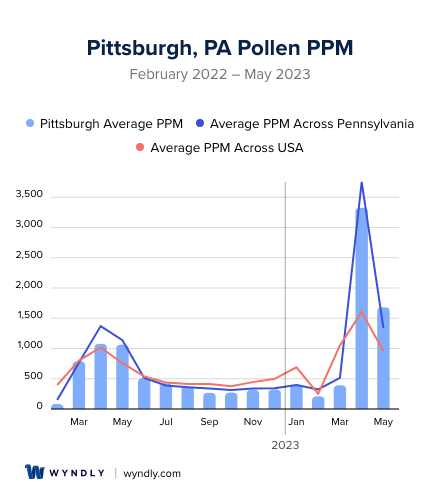
Pittsburgh, PA Pollen and Allergy Breakdown by Month
Grass
When is grass pollen highest in Pittsburgh, PA?
April has the highest grass pollen in Pittsburgh, PA with an average PPM of
When is grass pollen lowest in Pittsburgh, PA?
December has the lowest grass pollen in Pittsburgh, PA with an average PPM of
Tree
When is tree pollen highest in Pittsburgh, PA?
April has the highest tree pollen in Pittsburgh, PA with an average PPM of
When is tree pollen lowest in Pittsburgh, PA?
October has the lowest tree pollen in Pittsburgh, PA with an average PPM of
Weed
When is weed pollen highest in Pittsburgh, PA?
April has the highest weed pollen in Pittsburgh, PA with an average PPM of
When is weed pollen lowest in Pittsburgh, PA?
February has the lowest weed pollen in Pittsburgh, PA with an average PPM of
Pittsburgh, PA Pollen Monthly Breakdown by Pollen Type
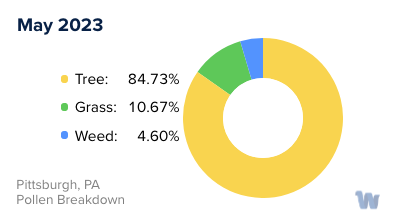






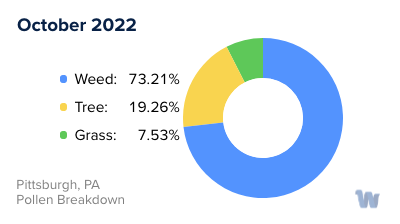
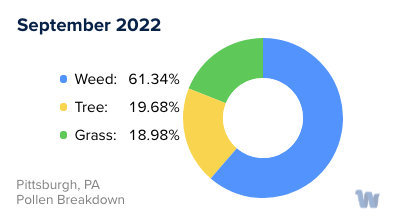
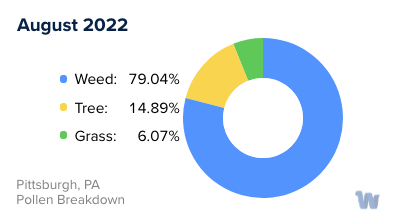


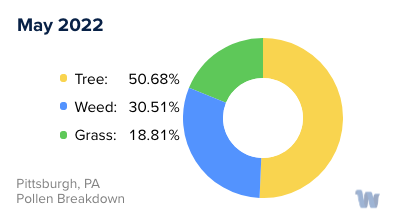
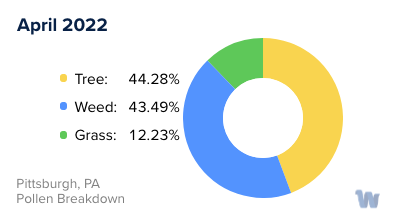

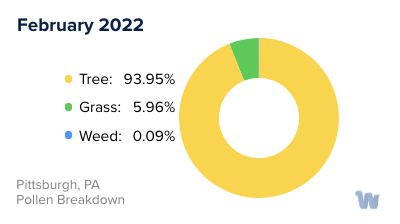
Pollen and Hay Fever in Pittsburgh, PA
Allergies can be a seasonal nuisance or a year-round trial for many people, and in Pittsburgh, Pennsylvania, one of the most common triggers is pollen. But what exactly is pollen, and why does it cause allergies in some individuals?,Pollen is a fine, powdery substance produced by trees, grasses, and weeds as a part of their reproductive process. It's carried through the air, and when inhaled by someone who's allergic, it can cause an immune response that results in the symptoms we know as hay fever, or allergic rhinitis.
In Pittsburgh, there are three main types of pollen that are most likely to trigger allergies: tree pollen, grass pollen, and weed pollen.
Tree pollen tends to be most prevalent in the spring. The primary offenders in Pittsburgh include oak, maple, pine, and birch trees. Each tree releases its pollen at different times, making the tree pollen season quite lengthy, usually from late February to late June.
Grass pollen follows closely behind, with its peak season falling in late spring and early summer. The types of grasses that commonly cause allergies in Pittsburgh include Kentucky bluegrass, ryegrass, and fescue.
Lastly, weed pollen takes over in late summer and continues into the fall. The most common types of weed pollen in Pittsburgh come from plants like ragweed, sagebrush, and lamb's quarters.
While the timing and severity of each pollen season can vary from year to year, depending on factors like weather patterns and rainfall, these general trends hold true for most years.
For those who are allergic, these pollens can cause symptoms such as sneezing, itchy or watery eyes, and a runny or stuffy nose. Being aware of the types of pollen and the seasons in which they are most prevalent can help individuals anticipate and manage their symptoms, even though the focus of this discussion is not on remedies or treatments.
In conclusion, pollen allergies, or hay fever, are a significant issue for many residents of Pittsburgh, with tree, grass, and weed pollens being the main culprits throughout different times of the year.


